Linguistic Studies in Ancient West Semitic Series (7 vols.)
Digital Logos Edition
Overview
Students and serious scholars will appreciate the detailed linguistic analysis and practical instructions found in this seven-volume collection. The Linguistic Studies in Ancient West Semitic Series gathers expert scholarship on phonology, morphology, and syntax of biblical Hebrew and Ugaritic.
Save time and strengthen your study of ancient languages with Logos Bible Software. The Linguistic Studies in Ancient West Semitic Series integrates into your personal digital library, allowing you to cross-reference with other dictionaries and resources you own. Perform comprehensive searches and compare the opinions of ancient-language experts side by side.

- Research from top linguistics scholars
- Detailed analysis of phonology, morphology, and syntax of ancient languages
- Valuable discussions for students at introductory and scholarly levels
- Title: Linguistic Studies in Ancient West Semitic Series
- Publisher: Eisenbrauns
- Volumes: 7
- Pages: 2,444
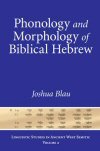
Phonology and Morphology of Biblical Hebrew began as an introduction to biblical Hebrew first written 40 years ago. It has now been translated from modern Hebrew, thoroughly revised, and updated; it distills a lifetime of knowledge on the topic. The introduction locates biblical Hebrew in the Semitic family of languages. Blau then discusses methods of categorization and classification, and introduces necessary linguistic approaches and features.
After a brief discussion of phonetics, the main portion of the book is devoted to phonology and morphology. In the section on phonology, Blau provides complete coverage of the consonant and vowel systems of biblical Hebrew and the factors that have affected both systems. In the section on morphology, he discusses the parts of speech (pronouns, verbs, nouns, numerals) and includes brief comments on the prepositions and “waw.” The book concludes with a complete set of paradigms and extensive indexes.
Blau’s preeminence as a Hebraist and Arabist have converged in this volume to provide an invaluable tool for the comparative and historical study of biblical Hebrew phonology and morphology.
[T]his book should be part of any institutional library where biblical Hebrew is taught. Those who instruct others in biblical Hebrew, especially beyond the beginning level, may also want to add this volume to their collection for the discussion of various aspects of phonology and of the historical development of biblical Hebrew
—Andrew Steinmann, distinguished professor of theology and Hebrew, Concordia University Chicago
The volume contains a wealth of information in an easily accessible format. All advanced grammatical concepts are explained briefly and the discussions are illustrated by clear examples. It is a very useful book for students and scholars alike.
—L. S. Tiemeyer, professor, University of Aberdeen
Joshua Blau is the Max Schlossinger Professor Emeritus of Arabic Language at the Hebrew University. He is the author of The Emergence and Linguistic Background of Judaeo-Arabic, A Handbook of Early Middle Arabic, Topics in Hebrew and Semitic Linguistics, and more.
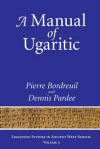
Pierre Bordreuil and Dennis Pardee are two of the best-known scholars doing research on the language and texts of the ancient city of Ugarit (modern Tell Ras Shamra). A Manual of Ugaritic includes a historical introduction to the texts and language, a sketch of the grammar of Ugaritic, a bibliography, hand-copies of many texts, and a glossary and text concordance—everything a student needs to study this fascinating language.
Anyone who teaches or studies Ugaritic will want to take a serious look at adding this book to his or her collection of resources. I had high hopes for this book and I was not disappointed.
—Karyn Traphagen
. . . I am able to recommend enthusiastically the use of this manual in graduate classrooms and its presence on the shelf of anyone heavily involved in reflection on the alphabetic texts from Ugarit. This is a well-produced volume from beginning to end. The diligent labor of two senior scholars over nearly three decades has produced an extremely useful grammar and chrestomathy of Ugaritic, now available in English at a competitive price.
—Jeremy Hutton, assistant professor of Old Testament, Princeton Theological Seminary
Pierre Bordreuil is chair in Ugaritic at the Écoles des Langues et Civilisations Orientales at the Institut Catholique de Paris.
Dennis Pardee teaches in the Department of Near Eastern Languages and Civilizations at the Oriental Institute of the University of Chicago.
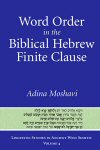
Over the last 40 years, the study of word-order variation has become a prominent and fruitful field of research. Researchers of linguistic typology have found that every language permits a variety of word-order constructions, with subjects, verbs, and objects occupying varying positions relative to each other.
Moshavi’s study investigates word order in the finite nonsubordinate clause in classical biblical Hebrew. A common marked construction in this type of clause is the preposing construction, in which a subject, object, or adverb is placed before the verb. Moshavi formally distinguishes preposing from other marked and unmarked constructions and explores the distribution of these constructions in biblical Hebrew. She carries out a contextual analysis of preposed clauses in sample passages to demonstrate how to determine the pragmatic functions that preposing may express.
This meticulous yet approachable study will be useful both to students of biblical Hebrew and to people studying general syntax, especially those interested in the connection between linguistic form and pragmatic meaning.
Moshavi deftly combines an interdisciplinary approach with a clearly-defined focus, and this combination represents one of the book’s greatest strengths. The study carefully brings insights from general linguistic literature, particularly from the information structure school, into dialogue with biblical Hebrew grammar, shining fresh light on perplexing questions. As a result, Moshavi’s volume constitutes a solid and worthwhile installment in [the] Linguistic Studies in Ancient West Semitic Series.
—Hubert James Keener
Adina Moshavi is senior lecturer in the department of Hebrew and Semitic language at Bar Ilan University in Israel. She has published several articles in journals around the world.
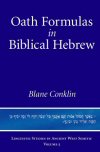
In the story of Ruth, the eponymous protagonist is so desperate to follow her widowed mother-in-law back to Israel that she swears an oath. Regardless of the translation one chooses, the sense is the same: Ruth promises to stay with Naomi for at least as long as they both shall live. But Ruth’s intention with respect to the two widows’ postmortem proximity is not so unanimous in the translations. According to the NRSV, Ruth says, “May the Lord do thus and so to me, and more as well, if even death parts me from you!” The NJPSV is representative of many other translations with its rendering, “Thus and more may the Lord do to me if anything but death parts me from you.” The difference may seem trivial, but the contradiction between the phrases is total—either death will not ultimately separate them, or it will.
The issue here is neither theological, nor archaeological. It is of a linguistic nature. What does the Hebrew phrase mean? The solution to the problem is fairly straightforward. The first step is to recognize that Ruth’s statement is an oath. Oaths often employ formulaic, elliptical phrases. Therefore, it is necessary to gather together in one place as many of these formulas as possible so that the patterns, tendencies, and divergences may be seen within a larger matrix. Conklin’s study intriguingly compiles these phrases and formulas in order to solve the mystery of interpreting biblical Hebrew oath formulas.
Conklin’s study successfully gathers together data that is helpful in addressing the various markers that introduce biblical oaths. In doing so, he has elucidated the meaning and morphosyntactic function of these oath markers and illustrated the way in which certain oath particles mirror the use of these particles in biblical Hebrew . . . there is little doubt that this study represents an original linguistic contribution to the study of oaths and contains some important new understandings of various oath formulae and the particles that introduce them.
—Yael Ziegler, Herzog College, Israel
Blane Conklin currently works for the University of Texas at Austin. He is the author of books and articles relating to biblical Hebrew.
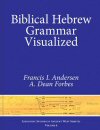
In Biblical Hebrew Grammar Visualized, Francis Andersen and A. Dean Forbes approach the grammar of biblical Hebrew from the perspective of corpus linguistics. Their pictorial representations of the clauses making up the biblical texts show the grammatical functions and semantic roles of clausal constituents, as well as the grammatical relations that bind the constituents into coherent structures.
This book carefully introduces the Andersen-Forbes approach to text preparation and characterization. It describes and tallies the kinds of phrases and clauses encountered across all of biblical Hebrew. It classifies and gives examples of the major constituents that form clauses, focusing especially on the grammatical functions and semantic roles. The book presents the structures of the constituents and uses their patterns of incidence both to examine word order and to characterize the relations among verb corpora. It expounds in detail the characteristics of quasiverbals, verbless clauses, discontinuous and double-duty clausal constituents, and supra-clausal structures.
This volume is intended for students of biblical Hebrew at all levels. Beginning students will readily grasp the basic grammatical structures making up the clauses because they are few and fairly simple. Intermediate and advanced students will profit from the detailed descriptions and comparative analyses of the structures making up the biblical texts. Scholars will find fresh ways of addressing open problems, while gaining glimpses of new research approaches and topics along the way.
At times the authors challenge the status quo and argue against the standard reference grammars, and the analysis behind their work makes it difficult to argue with their results. This is a text to be taken seriously, and could potentially change the way certain aspects of the Hebrew language are viewed.
—Matthew James Hamilton
Francis I. Andersen is an Australian scholar and biblical Hebrew expert. Together with A. Dean Forbes, he pioneered computer analysis of biblical Hebrew syntax. He has taught and worked in leadership at several institutions across Australia and the United States. He is the author of Studies in Hebrew and Aramaic Orthography and has contributed to the Anchor Yale Bible, Tyndale Commentaries, and more.
A. Dean Forbes manages speech recognition research at Hewlett-Packard Laboratories. He obtained his degrees from Harvard and the Pacific School of Religion. His interests include computer-assisted research in linguistics. Together with Francis I. Andersen, he pioneered computer analysis of biblical Hebrew syntax.
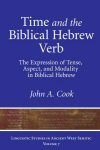
In this book, John Cook interacts with a range of approaches to perennial questions on the Hebrew verb. Some of his answers may appear traditional, such as his perfective-imperfective identification of the qatal-yiqtol opposition, but his approach is distinguished by its modern linguistic foundation. One distinguishing sign is his employment of the phrase “aspect prominent” to describe the biblical Hebrew verbal system. As with almost any of the world’s verbal systems, this aspect-prominent system can express a wide range of aspectual, tensed, and modal meanings. He argues that each of the forms can be semantically identified with a general meaning and that the expressions of specific aspectual, tensed, and modal meanings by each form are explicable with reference to its general meaning.
Cook eschews statistical means of validation, pointing out their weaknesses along the way, and draws on diachronic typology as an “external” means of validating his theory. These fields have provided a wealth of data on verbal systems and diachronic changes to these systems in the world’s languages. Given the inescapable diachronic dimension that is part of studying the ancient, composite corpus of the Hebrew Bible, diachronic typology is an especially suitable approach and a particularly useful means of escaping the subjectivity of translation-based statistical approaches.
After a decade of research and creative thinking, the author frames his discussion with the question, “What is the range of meaning for a given form, and what sort of contextual factors (syntagm, discourse, etc.) help us understand this range in relation to a general meaning for the form?” Although the general meaning may be an abstraction (just as a morpheme or phoneme is an abstraction), it gives us a better understanding of the array of specific meanings a form may exhibit and predicts the types of contexts in which these specific meanings may appear.
In order to account for the contextual character of specific meanings, Cook addresses long-standing issues involving interaction between the semantics of verbal forms and their pragmatic functions. More importantly, he proposes a theory of discourse modes for biblical Hebrew. These modes account for various temporal relationships that are found among successive clauses in biblical Hebrew. Fittingly, his account of this theory of discourse modes ends on an exegetical note with an explication of the interaction of verbs and their discourse context in two passages from the Hebrew Bible.
Cook’s brilliant work addresses old questions with a fresh approach that is sure to provoke dialogue and new research.
Dr. John A. Cook is an expert in the Hebrew language and biblical poetry. He received his MA from Trinity Evangelical Divinity School and his PhD from the University of Wisconsin–Madison. He teaches at Asbury Theological Seminary and is the coauthor of Biblical Hebrew: An Illustrated Introduction.
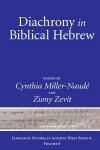
Diachrony in Biblical Hebrew is an indispensable publication. Scholars of language will want to read these essays for the latest perspectives on the historical development of biblical Hebrew. Hebraists and linguists interested in the history of the Hebrew language will appreciate the studies that address the language’s development during the Iron Age, the Neo-Babylonian and Persian periods, and the early Hellenistic period.
Written for both “text people” and “language people,” this is the first book to address established historical-linguistics theory as it applies to the study of Hebrew, and to focus on the methodologies appropriate for biblical Hebrew and Aramaic. Diachrony in Biblical Hebrew provides exemplary case studies of orthography, lexicography, morphology, syntax, language contact, dialectology, and sociolinguistics; because of its depth of coverage, it has broad implications for the linguistic dating of biblical texts. The book finishes with useful histories of linguistic diachrony in Aramaic, Ugaritic, and Akkadian—the three languages related to and considered most crucial for biblical research.
Cynthia L. Miller is an expert in biblical Hebrew linguistics. She was the chair of the Department of Hebrew and Semitic Studies at the University of Wisconsin–Madison and is currently a professor at the University of the Free State in South Africa. She is the author of The Verbless Clause in Biblical Hebrew: Linguistic Approaches.
Dr. Ziony Zevit is distinguished professor of Biblical literature and Northwest Semitic languages at American Jewish University. He taught at the University of Haifa, Ben-Gurion University of the Negev, the Hebrew University of Jerusalem, and the University of California–Berkeley. He is the recipient of several fellowships and awards and the author of over 100 publications, including The Anterior Construction in Classical Hebrew, The Religions of Ancient Israel: A Parallactic Approach, and Matres Lectionis in Ancient Hebrew Epigraphs.
Reviews
5 ratings
Dr. Anthony Mazak
7/28/2022
Eva Mari Hermosa
3/4/2018

Charles
9/28/2017


David J. Wilson
11/1/2014
https://www.logos.com/product/7859/the-verbless-clause-in-biblical-hebrew-linguistic-approaches Seems to be Volume 1 in this series (not included in the above)Bobby Terhune
10/18/2013